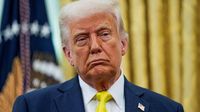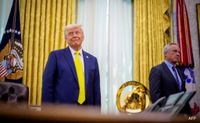In a dramatic escalation of tensions between Harvard University and the Trump administration, a letter received by the university on April 11, 2025, outlined a series of controversial demands that the administration claimed were necessary for Harvard to continue receiving federal funding. The letter, which included stipulations regarding hiring practices, admissions procedures, and the discontinuation of diversity, equity, and inclusion (DEI) programs, was met with immediate rejection by Harvard.
Harvard President Alan M. Garber firmly stated, "The University will not surrender its independence or relinquish its constitutional rights." This declaration came just three days after the letter's arrival, underscoring the university's unwillingness to bow to what it deemed intrusive government overreach.
Following Harvard's refusal to comply with the demands, the Trump administration froze approximately $2.3 billion in federal funding, threatening to rescind the university's tax-exempt status and restrict its ability to enroll foreign students. The administration's actions marked a significant escalation in an ongoing battle between elite universities and the government, particularly in the context of rising concerns over antisemitism on campuses.
According to a report by the New York Times, the April 11 letter was deemed “unauthorized,” with conflicting accounts emerging from within the White House regarding how it was mishandled. Some officials believed it had been sent prematurely, while others contended it was intended only for internal discussion.
Despite the confusion surrounding the letter's dispatch, the White House confirmed its authenticity on April 19, 2025, with a senior official stating that the administration stood by the letter's content. This response came after Harvard publicly condemned the demands, describing them as "astonishing in their overreach."
The letter's demands included a ban on masks at campus protests, a directive to limit student activism, and a requirement to monitor international students. Harvard was also urged to appoint faculty members who align more closely with conservative viewpoints. These stipulations were framed by the administration as necessary measures to combat antisemitism, particularly in light of recent protests related to the Israel-Hamas conflict.
In the wake of Harvard's rejection, the Trump administration's response was swift and severe. On April 14, 2025, it announced the freezing of $2.2 billion in multi-year grants, alongside $60 million in multi-year contracts. Furthermore, the Internal Revenue Service was reported to be considering the revocation of Harvard's tax-exempt status, a move that could have significant financial repercussions for the institution.
In a statement, a Harvard spokesperson highlighted the serious implications of the administration's actions, noting, "Even assuming the administration now wishes to take back its litany of breathtakingly intrusive demands, it appears to have doubled down on those demands through its deeds in recent days. Actions speak louder than words."
As the situation unfolded, it became clear that the Trump administration's aggressive stance was part of a broader strategy aimed at reshaping higher education in the United States. In recent months, other prestigious universities, including Columbia, have faced similar pressures, with the administration threatening funding cuts unless they comply with specific policy changes.
Columbia University had previously made concessions to the administration, altering its policies in response to threats of funding withdrawal over campus protests. This precedent raised concerns among Harvard officials about the potential consequences of standing firm against the Trump administration's demands.
In a further twist, Josh Gruenbaum, a top lawyer at the General Services Administration, reportedly made a frantic call to one of Harvard’s attorneys shortly after the university's public announcement. He claimed that the letter had not been authorized for release, a statement that added to the confusion surrounding the administration's intentions.
However, the White House remained resolute, asserting that the letter's demands were necessary for ensuring compliance with civil rights laws and addressing concerns about antisemitism on campus. May Mailman, a senior policy strategist at the White House, criticized Harvard's legal team for failing to confirm the contents of the letter before going public, suggesting that the university had overreacted.
Despite the administration's insistence that dialogue was still possible, Harvard officials expressed skepticism about the potential for constructive negotiations. They noted that the demands outlined in the letter represented direct governmental regulation of the university's intellectual environment rather than legitimate efforts to combat antisemitism.
In a statement, Harvard reiterated its commitment to academic freedom and independence, stating, "Recipients of such correspondence from the U.S. government—even when it contains sweeping demands that are astonishing in their overreach—do not question its authenticity or seriousness." The university emphasized that the administration's actions have real-life consequences for students, faculty, and the broader landscape of American higher education.
This confrontation between Harvard and the Trump administration reflects a growing divide between elite institutions and government authorities over issues of academic freedom and institutional autonomy. As the battle continues, the implications for higher education in the United States remain uncertain, with many watching closely to see how both sides navigate this contentious landscape.
As the situation unfolds, it becomes increasingly clear that the stakes are high, not only for Harvard but for universities across the nation. The outcome of this dispute could set important precedents regarding the relationship between higher education and federal funding, as well as the broader implications for academic freedom in the years to come.








